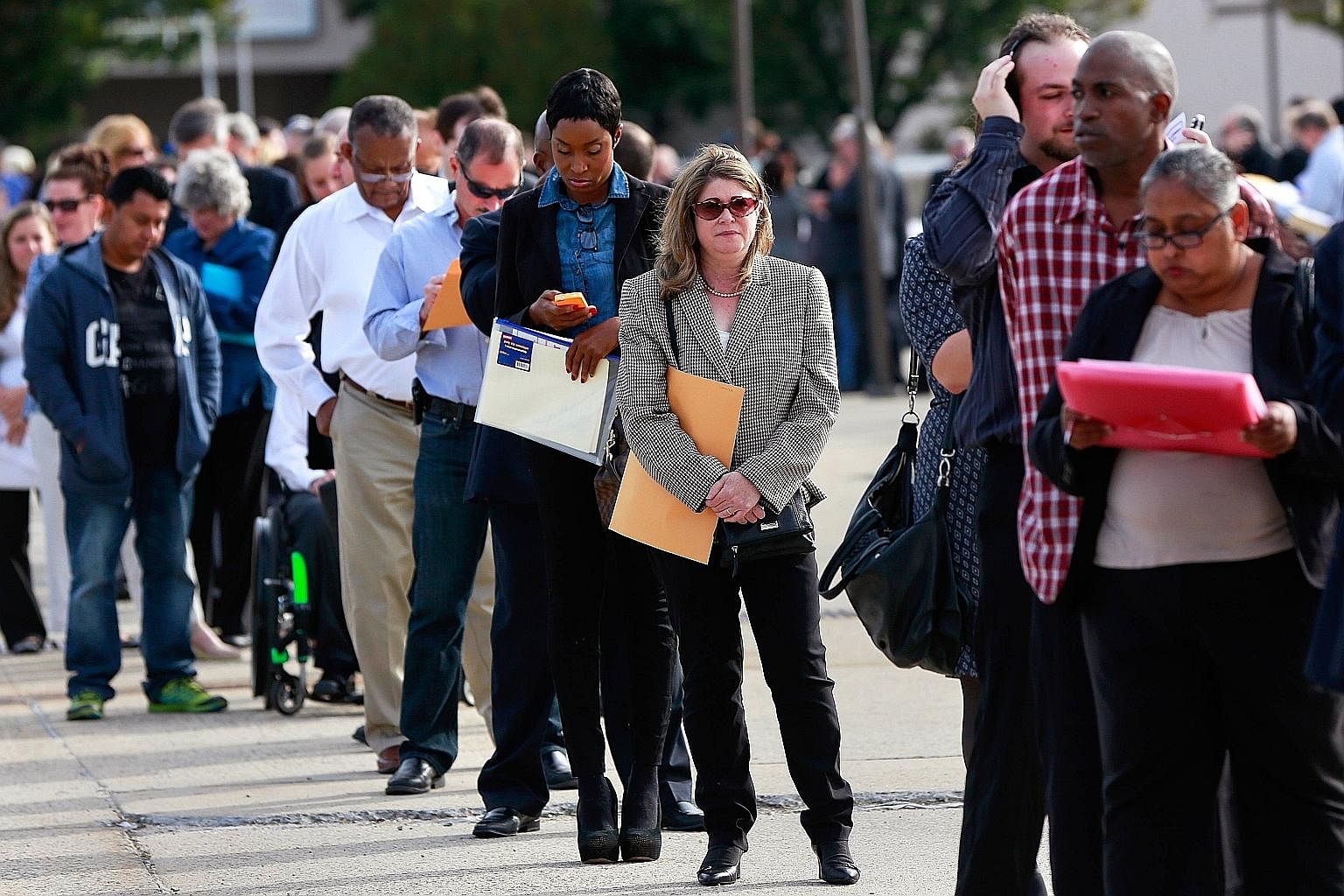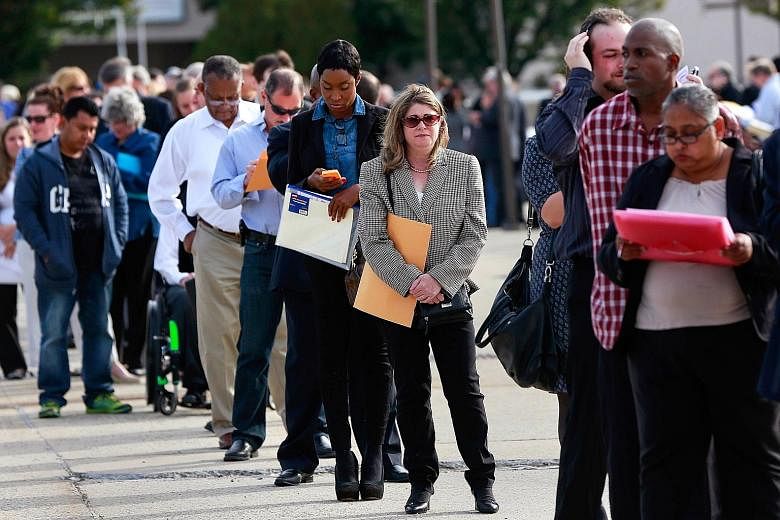Should the goal of public policy be to ensure that all Americans can have good jobs - or good lives? Politicians of both parties say one thing. Policy experts of both parties say another.
Politicians routinely promise that, if elected, they will create more good jobs, which are understood to be jobs with solid wages, regular hours and, perhaps, generous employer-provided benefits.
In this campaign year, Mrs Hillary Clinton promises "the biggest investment in good-paying jobs since World War II" by means of a mixture of tough trade negotiations, investment in domestic manufacturing, infrastructure investment, research and development, regulatory relief for small business, debt-free higher education and a tax credit to subsidise apprenticeships.
Mr Donald Trump proposes to protect American workers from competition with illegal immigrants, the offshoring of jobs by US-based corporations and harmful practices by trading partners like China.
Far from the campaign stops, in university and think-tank offices, the emerging consensus is quite different: Americans should be able to enjoy good lives, even if they have "bad" jobs - jobs with low wages, irregular hours and no employer-provided benefits.
Bipartisan experts tend to agree that the decline in employer-provided benefits and the rise of unconventional work arrangements are trends that should be accommodated, by reforms including new portable benefits and expanded income- maintenance programmes, like tax credits for low-income workers.

For several decades, this consensus has been reflected in what legislators have actually been doing. Slowly, incrementally, Americans have been moving away from a system in which a good job with a generous employer was the key to having a good life, to a new system in which even people with low-wage jobs can have access to the basic goods and services that define a decent life in a modern society.
One piece of the new system includes the earned-income tax credit (EITC), a means-tested wage subsidy that has enjoyed bipartisan support since its creation in 1975. Expanding wage subsidies is one way to compensate for the low wages paid by many of the new jobs that are being created. According to the Bureau of Labour Statistics, 94.6 per cent of jobs added from 2014 to 2024 will be in the service sector. The single largest employer of near-minimum wage workers, the restaurant and food service industry, is one of the sectors with the greatest projected job growth.
Another example is provided by jobs in the healthcare and social assistance sector. These jobs are projected to grow much more rapidly than the average for all occupations, increasing by 38 per cent between 2012 and 2024, and accounting for 3.8 million of the 9.3 million new service sector jobs. Many health-related jobs are poorly paid. Home health aides, who need no formal educational credentials and whose median annual wage is US$21,850 (S$29,830), now significantly outnumber better-paid and better-educated licensed nurses (median wage: US$43,090). And low-wage home health aides are more than three times more numerous than medical and health services managers (median wage: US$92,710).
Support for expanding the EITC or other wage subsidies to compensate for low-wage service jobs like these is shared by Republicans like House Speaker Paul Ryan and progressives like former labour secretary Robert Reich. The EITC supplements statutory federal and state minimum wages. Mrs Clinton supports a federal minimum wage of US$12 to US$15 an hour; Mr Trump says he supports an increase to US$10.
Meanwhile, fewer employers are providing health insurance to their workers. As of March, no more than 41 per cent of workers in the bottom quarter of wage earners had access to sick leave. Part-time workers are even worse off. The Patient Protection and Affordable Care Act - Obamacare - enacted into law in 2010 sought to ensure that all Americans without employer-provided health insurance had access to affordable health insurance, through either Medicaid, state-regulated exchanges or a federal exchange.
Employer-provided, defined-benefit pensions with guaranteed benefits are also becoming a thing of the past. Among workers fortunate enough to participate in employer-sponsored retirement plans, defined-benefit pensions alone plummeted from more than 60 per cent in 1979 to fewer than 10 per cent in 2011, when around 70 per cent of workers with employer plans had 401(k)s. Roughly half of American workers don't have access to an employer- sponsored retirement plan.
So it's no surprise that nearly half of working-age families have no retirement savings at all - and for individuals between 56 and 61, the median retirement account holds only US$17,000. Here again, many Democrats and Republicans agree that the answer is to detach retirement security from particular employers, though it should still depend on how much you work.
A number of states have considered creating state- sponsored retirement savings plans for private-sector workers without employer-provided retirement savings plans. California, Illinois, Oregon and Massachusetts have already established such schemes. California's new Secure Choice plan will require employers that do not provide 401(k)s to automatically enrol their workers in an individual retirement account.
From the 1970s to the present, then, mostly with bipartisan support (the glaring exception was Obamacare), US policymakers have responded to the decline of high-wage jobs and generous employer-based benefits by gradually expanding the role of the government in ensuring that Americans have adequate income and adequate benefits.
Most of this expansion has taken place in what political scientist Christopher Howard calls "the hidden welfare state" and political scientist Suzanne Mettler describes as "the submerged state". This huge government sector is made up of tax credits, federal grants-in-aid to the states and low-interest loan programmes like student loans. Many of these indirect programmes, like entitlements and tax breaks for healthcare, retirement and housing, are not counted as part of the conventional federal budget. This allows Congress to stealthily expand the size of government while pretending not to. The individual mandate of the Affordable Care Act, for example, is a tax - though an unusual one, as the Supreme Court found when upholding its legitimacy in 2012.
In terms of direct spending on social welfare, the United States seems miserly compared with many other developed nations. But according to a recent study for the Peterson Institute for International Economics by Mr Jacob Funk Kirkegaard, this is an illusion. When tax-favoured private social spending is combined with public spending, US public expenditures at 20.8 per cent of GDP are only a little lower than the average in 21 states of the European Union.
Mr Kirkegaard concludes: "Taking the full effects of tax systems and social spending from both private and public sources into account, the United States is seen to be devoting more resources towards social purposes than is generally acknowledged."
Preserving the fiction of a small federal government by relying on the hidden welfare state to deliver benefits sometimes comes at a cost. For example, unemployment insurance is not a simple, straightforward, uniform federal programme, but a hodgepodge of separate state programmes financed partly by the federal government and partly by the states. During economic downturns, this design often creates crises because the federal government can more easily borrow money in recessions than state governments bound by balanced-budget provisions in their state Constitutions.
And as political scientist Mettler has pointed out, the importance of indirect benefits in America creates political problems, too. Middle-class American voters often underestimate how many government benefits they receive, while overestimating the cost of means-tested welfare for the poor. Unfortunately, the preference of US policymakers for what political scientist Steven Teles calls "kludgeocracy" - indirect, complex, off-budget mechanisms rather than simple public programmes financed through higher taxes - seems likely to persist.
Looking back over the last half-century, we can discern a long-term trend in which the US government at all levels has been gradually responding to the decline of high-wage, high-benefit jobs by methods such as gradually socialising benefits (state-run retirement plans) and partly subsidising wages (the EITC). Is this a trend to be welcomed or feared?
One criticism is that the growing socialisation of wages and benefits, combined with the decline of employer-provided benefits, transfers responsibility for the well-being of workers from employers and their customers to taxpayers. But any welfare state of any design allows employers to pay somewhat lower wages, because workers do not have to pay for goods like retirement security or healthcare entirely from their after-tax earnings.
But the political problem remains. Even if centre-left and centre-right policy wonks agree that the goal should be good lives for all workers, even those with bad jobs, many Americans do not agree, to judge from the rhetoric of politicians, who know their audiences well. The replacement of a world in which one or a few lifetime jobs in a paternalistic company that provided benefits during your working life and a pension after your retirement by a future in which individuals struggle to survive by piecing together "gigs" and "tasks" with a bewildering variety of federal, state and local social programmes may strike many workers as a dystopian nightmare. The price of increased flexibility may be increased stress.
The emerging policy agenda tends to shift administrative burdens from employers to the least-educated and worst-paid workers in America. Members of the professional class who are well-remunerated freelancers and can hire tax preparers have a quite different experience of the new economy from high-school dropouts who, between part-time shifts, struggle with the paperwork for the EITC, food stamps and other benefits.
More opportunities for part-time work can benefit retirees, who are able to rely on Social Security for a basic income. And a Pew Research Centre poll in 2013 showed that half of working mothers say that part-time work would be ideal for them. For other workers, particularly those in low-wage service jobs, irregular and unpredictable working hours are often unwelcome.
The unelected policy experts who envision a future of multiple job types and a greater, if hidden, role for government in maintaining minimum incomes and providing health and retirement benefits are essentially right. The elements of a "good job" - adequate income, health insurance and retirement benefits - that were once combined in the package that a Detroit automobile manufacturer provided to a unionised male steelworker in 1950 are likely to be provided, for most American workers now, by some combination of employer and government.
Until most American workers are persuaded that they will not be worse off in a system characterised by flexible work arrangements and partly socialised benefits, they may continue to make unrealistic demands that 21st-century politicians restore something like the occupational structure of the 20th century. Politicians should tell working Americans what they need to hear, not what they want to hear. And what they need to hear is that it is possible for all Americans to have good lives, even if they can't all have good jobs.
NYTIMES
• The writer is a fellow at New America and the author, most recently, of Land Of Promise: An Economic History Of The United States.

